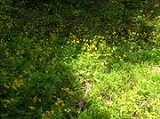
Arnica cordifolia
Encyclopedia
Arnica cordifolia is a species of arnica
known by the common name heartleaf arnica. It is native to western North America from Alaska
to California
to New Mexico
, and it is distributed as far east as Ontario
and Michigan
. It is a plant of many habitat types, including coniferous forests and mountain meadows.
This is a rhizomatous
perennial herb producing one or more erect stems reaching a maximum height near half a meter. It has two to four pairs of leaves on the stem, each on a long petiole
. The leaves are heart-shaped to arrowhead-shaped and finely toothed along the edges. The inflorescence
bears one or more daisylike flower heads
lined with white-haired phyllaries
and sometimes studded with resin glands. The center of each head contains golden yellow disc florets and a fringe of bright golden ray florets approaching 3 centimeters in maximum length.
The fruit is a hairy achene
up to a centimeter long, not counting its off-white pappus. Seeds are dispersed
on the wind. An individual plant can live twelve years, surviving periodic wildfire
by resprouting from its long, slender rhizome afterward.
Arnica
Arnica is a genus with about 30 perennial, herbaceous species, belonging to the sunflower family . The genus name Arnica may be derived from the Greek arna, "lamb", in reference to the soft, hairy leaves....
known by the common name heartleaf arnica. It is native to western North America from Alaska
Alaska
Alaska is the largest state in the United States by area. It is situated in the northwest extremity of the North American continent, with Canada to the east, the Arctic Ocean to the north, and the Pacific Ocean to the west and south, with Russia further west across the Bering Strait...
to California
California
California is a state located on the West Coast of the United States. It is by far the most populous U.S. state, and the third-largest by land area...
to New Mexico
New Mexico
New Mexico is a state located in the southwest and western regions of the United States. New Mexico is also usually considered one of the Mountain States. With a population density of 16 per square mile, New Mexico is the sixth-most sparsely inhabited U.S...
, and it is distributed as far east as Ontario
Ontario
Ontario is a province of Canada, located in east-central Canada. It is Canada's most populous province and second largest in total area. It is home to the nation's most populous city, Toronto, and the nation's capital, Ottawa....
and Michigan
Michigan
Michigan is a U.S. state located in the Great Lakes Region of the United States of America. The name Michigan is the French form of the Ojibwa word mishigamaa, meaning "large water" or "large lake"....
. It is a plant of many habitat types, including coniferous forests and mountain meadows.
This is a rhizomatous
Rhizome
In botany and dendrology, a rhizome is a characteristically horizontal stem of a plant that is usually found underground, often sending out roots and shoots from its nodes...
perennial herb producing one or more erect stems reaching a maximum height near half a meter. It has two to four pairs of leaves on the stem, each on a long petiole
Petiole (botany)
In botany, the petiole is the stalk attaching the leaf blade to the stem. The petiole usually has the same internal structure as the stem. Outgrowths appearing on each side of the petiole are called stipules. Leaves lacking a petiole are called sessile, or clasping when they partly surround the...
. The leaves are heart-shaped to arrowhead-shaped and finely toothed along the edges. The inflorescence
Inflorescence
An inflorescence is a group or cluster of flowers arranged on a stem that is composed of a main branch or a complicated arrangement of branches. Strictly, it is the part of the shoot of seed plants where flowers are formed and which is accordingly modified...
bears one or more daisylike flower heads
Head (botany)
The capitulum is considered the most derived form of inflorescence. Flower heads found outside Asteraceae show lesser degrees of specialization....
lined with white-haired phyllaries
Bract
In botany, a bract is a modified or specialized leaf, especially one associated with a reproductive structure such as a flower, inflorescence axis, or cone scale. Bracts are often different from foliage leaves. They may be smaller, larger, or of a different color, shape, or texture...
and sometimes studded with resin glands. The center of each head contains golden yellow disc florets and a fringe of bright golden ray florets approaching 3 centimeters in maximum length.
The fruit is a hairy achene
Achene
An achene is a type of simple dry fruit produced by many species of flowering plants. Achenes are monocarpellate and indehiscent...
up to a centimeter long, not counting its off-white pappus. Seeds are dispersed
Biological dispersal
Biological dispersal refers to species movement away from an existing population or away from the parent organism. Through simply moving from one habitat patch to another, the dispersal of an individual has consequences not only for individual fitness, but also for population dynamics, population...
on the wind. An individual plant can live twelve years, surviving periodic wildfire
Wildfire
A wildfire is any uncontrolled fire in combustible vegetation that occurs in the countryside or a wilderness area. Other names such as brush fire, bushfire, forest fire, desert fire, grass fire, hill fire, squirrel fire, vegetation fire, veldfire, and wilkjjofire may be used to describe the same...
by resprouting from its long, slender rhizome afterward.

